|
Bull's Eye Investing Ten Years Later
It's been almost a decade since I co-authored with Ed Easterling of Crestmont Research some research in this letter that later became chapters five and six of Bull's Eye Investing. Although the ten-year anniversary of the book is actually 2013, the current vulnerabilities in the markets encouraged us to revisit the material a bit early, to prepare you for what lies ahead. Reflecting back to yesteryear gives us the opportunity to assess the accuracy of our insights.
Bull's Eye Investing (Almost) Ten Years Later
By John Mauldin and Ed Easterling
Our discussion of a coming secular bear market almost ten years ago was not hypothetical forecasting, but rather it was a discussion about the fundamental factors that drive stock market returns. Even though it is challenging to predict the market over months and quarters or even a few years, we believe the data shows that the stock market is quite predictable over some longer periods. Those periods are the secular stock market cycles of above-average bulls and below-average bears.
In the opening paragraphs of chapter five, in bold emphasis, we wrote:
We will make the case that it is more useful to analyze stocks during secular bear markets in terms of value than in terms of price... These cycles generally take a generation to work their way through the investor public, have significant magnitudes of becoming undervalued and overvalued, and have significant implications for the way that investors should approach each of these periods.
We emphasized that:
Further, we show that volatility and frequent large rallies are the norm and not the exception, thus giving the astute investor some terrific opportunities. Finally, we will make a connection between inflation, interest rates, and stocks that will give us further indications of the direction of the stock and bond market in the coming decade.
If the cycles of the past century continue to repeat, most of the first decade (or more) of this century will experience a secular bear market – an extended period of generally down or sideways and choppy stock market conditions....
These periods in the past have been the result of market valuation cycles represented by the P/E ratio. The valuation cycles have resulted from generally longer-term trends in inflation toward or away from price stability. The short-term, somewhat random, market gyrations are the result of then-current circumstances and market forces wrestling stock prices around a gravity line of the broader cyclical trend.
What did P/E do over the past decade and where is it today? What does it tell us about the future? What new insights can we glean by adding nine years of history to some of the charts and graphs in the original chapters? In addition to chart updates, there are quite a few new charts here from Crestmont Research. Well, there is a lot to review as we look back over the past decade, with an eye on the next decade.
Reliving the Past Nine Years
For a good overview of the past nine years and this secular bear market, here's an update to Table 5.6 in Bull's Eye Investing. When we wrote the chapters in 2003, the charts and graphs were current through year-end 2002. At the time, P/E was a lofty 26 –though it had come down significantly from bubble levels in the 40s. To reduce the distortions to P/E caused by the earnings cycle, earnings (E) were normalized using the approach popularized by Robert Shiller at Yale (which uses earnings over a ten-year period). The resulting P/E is often called the cyclically adjusted P/E, or P/E 10.
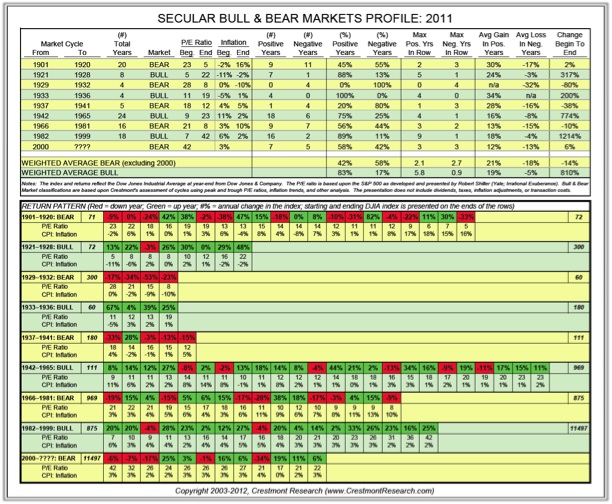
http://www.crestmontresearch.com/docs/Stock-Secular-Chart.pdf
There are several points to emphasize in the chart above. This secular bear (so far!) has been relatively calm compared to historical secular bears. The typical bear has more negative years than positive years (only 42% positive), yet this cycle so far has had more positive years (58% positive). The gain and loss years have been more muted, with gains and losses averaging around two-thirds of normal levels.
Certainly this secular bear has not been calm as we have experienced it in real time, but the relative calmness compared to past cycles may be an indicator of what lies ahead before the bear retires.
Some investors certainly do think the current secular bear has been extreme. Here's what it has brought us so far:
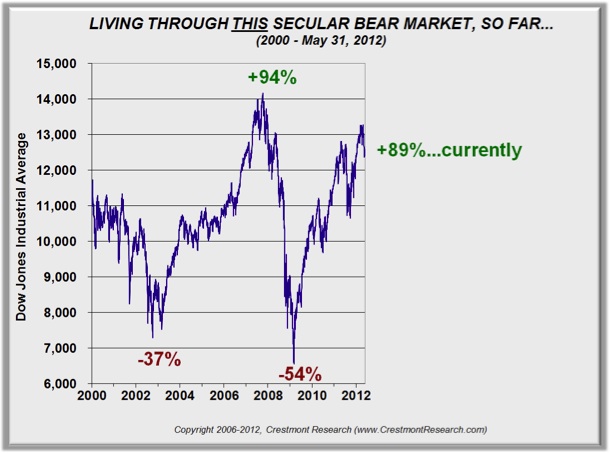
http://www.crestmontresearch.com/docs/Stock-This-Secular-Bear.pdf
The pattern and process have not been very different from what we expected in 2003. As we wrote in Bull's Eye Investing, "... volatility and frequent large rallies are the norm and not the exception" in secular bear markets. Here's the previous secular bear (1966-1981) as an example. Yes, the 54% decline by 2009 was greater than the 45% in 1974, but the pattern of numerous short-term surges and falls had again repeated.
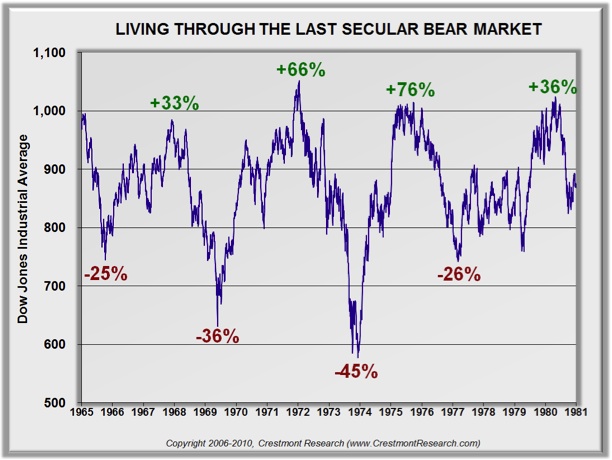
There is another approach to assessing volatility that was included in Bull's Eye Investing. Table 5.1 revealed that the stock market is much more volatile than most people realize. Rather than use confusing and boring statistics, we took more of a layman's approach. We highlighted that the market moves up or down more than 10% annually in almost 70% of the years. It moves more than 16% in either direction in half of all years. So what has happened so far in the present cycle?
Crestmont has updated that volatility analysis through 2011, and it now reveals new insights by breaking out separate details for bulls and bears. It is striking that overall volatility is relatively similar for secular bulls and bears. Note the frequency inside the 10% and 16% ranges. In both secular bulls and bears, nearly 30% and 50% of the years fall inside the respective ranges. The difference is that bulls predominantly have upside years, while bears have more downside years.
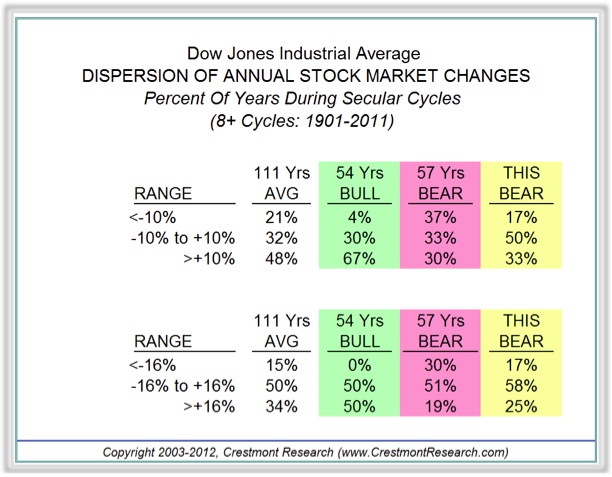
The results so far for this secular bear have been a bit different. First, there have been more inside years – another indication that the first part of this secular bear has been a bit tamer than usual. Second, notwithstanding the crisis plunge into 2009, the downside years have been under-represented. Why?
So far, this secular bear has not made much progress through the fundamental process that a secular bear must undergo. As we highlighted in Bull's Eye Investing, "The valuation cycles have resulted from generally longer-term trends in inflation toward or away from price stability." Other than an occasional flirt with deflation or inflation over the past decade, we're stayed relatively close to price stability. There are certainly lots of pressures building for deflation and inflation, either of which would drive this secular bear to its den. But for now, the choppiness has us in a bit of a holding pattern. The stock market's gyrations and underlying earnings growth over the past nine years have driven P/E from the mid-twenties to the low twenties, but the market has yet to experience the full process of valuation declines in the face of an adverse inflation rate trending into deflation or high inflation.
Are We There Yet?
Here are two new charts from Crestmont Research that explain how we got here and just how much farther we have to go. The charts reflect the normalized P/E ratio for the S&P 500 Index for all secular bull and secular bear cycles since 1900. The lines on the charts show the price/earnings ratio (P/E) over the life of each secular cycle.
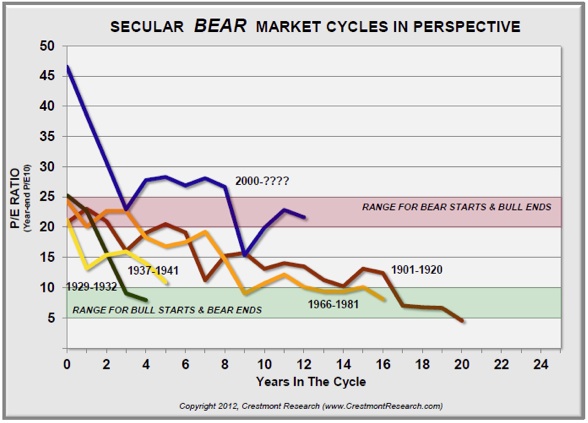
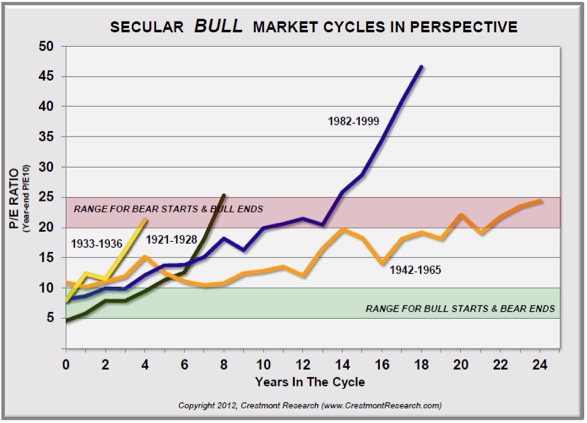
First, note that secular bulls start when P/E is low and end when P/E is high. Similarly, secular bears start when P/E is high and end when P/E is low. In the charts, the low range is designated with green shading and the typical high range is shaded red.
Look at the secular bull of the 1980s and 1990s. It is as though that secular bull ran its course through the mid-1990s, then P/E more than doubled again. The already high P/E ascended to the bubblesphere.
Compare the two graphs. Every secular bear cycle prior to our current one followed a secular bull that ended with P/E in or near the red zone. That set the starting point for every subsequent secular bear. But this time, the super secular bull of the late 1990s ended nearly twice as high – it was a major bubble. The past twelve years saw the bubble popped and P/E restored to levels typically associated with a low inflation rate. It has taken more than a decade to wear away the effects of the late 1990s extremes.
The current valuation of the stock market is relatively high, but it is not overvalued, considering today's conditions. Low inflation-rate conditions should be accompanied by relatively high P/Es. But if deflation or high inflation (or both) are likely upcoming, the market is very expensive. On the other hand, if the inflation rate happens to remain near price stability, then this secular bear could remain active a while longer – but how likely is that?
High P/E, Low Returns
In Bull's Eye Investing we explained that high market valuations (P/E) necessarily drive low long-term returns. This occurs because periods that start with high P/Es often end with lower P/Es, eating away at returns. Further, high-P/E periods have low dividend yields. As a result, we could write with confidence nine years ago that subsequent returns would be well below average.
In all cases, throughout the years, the level of returns correlates very highly to the trend in the market's P/E ratio. The P/E ratio is the measure of valuation as reflected by the relationship between the prices paid per share to the earnings per share (EPS). Higher returns are associated with periods during which the P/E ratio increased and lower or negative returns resulted from periods during which the P/E ratio declined.
This may be the single most important investment insight you will get from this book. When P/E ratios are rising, the saying that a "rising tide lifts all boats" has been historically true. When P/Es are dropping, stock market investing is tricky; index investing is an experiment in futility. As we will see in later chapters, in these secular bear market periods, successful stock market investing requires a far different (and sometimes opposite) set of skills and techniques than what is required in bull markets....
Given the current and recent level of P/Es, the prospects are not encouraging for general market gains (the emphasis is on general or index funds) over the next two decades. This dismal outlook is not from some congenital bear perspective; it corresponds to the series of factors driving the current secular bear market.
Although P/E has declined over the past nine years, from 26 to near 20 (using the Shiller method), stock market valuation remains relatively high. Almost everything in chapters five and six of Bull's Eye Investing remains true today. The market has chopped around with fairly typical volatility. P/E is in the lower end of the red zone rather than above it. Most importantly, currently high valuations portend low returns from here.
How low? That depends upon the outlook for deflation or higher inflation.
Our crystal balls are showing us different things on that question, although our fundamental conclusions are the same. Ed sees moderate probabilities for either higher inflation or deflation. On his optimistic side, he even allows for the prospect of continued price stability for quite some time. John, however, sees flashing danger signs of upcoming deflationary pulses, to be followed later by higher inflation. He outlined his reasoning in Endgame.
So, together, we have several scenarios. We have some side bets as to who will be right; but more importantly for you, none of the outcomes deliver good overall equity market returns, because we are still at a relatively high P/E.
Next week we will return to a few more paragraphs from Bull's Eye Investing, and then we will explore the implications of the entire analysis.
By the way, Ed has written a must-read book on the likely outcomes of the stock market over this decade. It enables the reader to see the impacts of key factors on their outlook. Probable Outcomes is packed with details and extensive full-color charts and graphs. Here's a link to it at Amazon: www.amazon.com/Probable Outcomes.
And John has condensed Bull's Eye Investing to a version for Wiley called The Little Book of Bull's Eye Investing, in which he focuses on the basics of secular cycles and absolute-return investing. The book is just out, and you can get it at your local bookstore or at www.amazon.com/Little Book of Bull's Eye Investing.
(For the record, Ed is the author of Probable Outcomes: Secular Stock Market Insights and the award-winning Unexpected Returns: Understanding Secular Stock Market Cycles. He is President of Crestmont Research, an investment management and research firm, and a Senior Fellow with the Alternative Investment Center at SMU's Cox School of Business, where he previously served on the adjunct faculty and taught the course on alternative investments and hedge funds for MBA students. He publishes provocative research and graphical analyses on the financial markets at www.CrestmontResearch.com, one of my favorite websites.)
John Mauldin is president of Millennium Wave Advisors, LLC, a registered investment advisor. Contact John at John@FrontlineThoughts.com.
Disclaimer
John Mauldin is president of Millennium Wave Advisors, LLC, a registered investment advisor. All material presented herein is believed to be reliable but we cannot attest to its accuracy. Investment recommendations may change and readers are urged to check with their investment counselors before making any investment decisions.
|